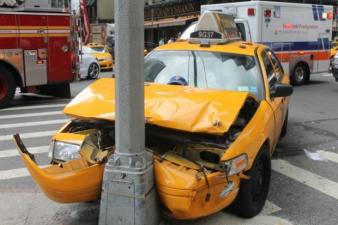Gov Signs 25 MPH Law — Here’s How Albany and NYC Can Make the Most of It

On Saturday, Governor Andrew Cuomo signed a bill lowering the default speed limit in New York City from 30 mph to 25 mph, a significant milestone for Mayor de Blasio’s Vision Zero initiative and a major accomplishment for victims’ families, street safety advocates, and their legislative allies in Albany. Here’s what to keep an eye on as the city tries to save lives by getting motorists to drive at safer speeds.
The new speed limit will take effect 90 days after Cuomo’s signature. After the first week of November, the speed limit on all surface streets in New York City will be 25 mph unless otherwise marked.
As AMNY reported last month, DOT will have its hands full in the near term, putting up 25 mph signs and adjusting traffic signals to synch up with the lower speed limit. The agency will continue to roll out these changes as part of its Arterial Slow Zone program, which will be targeting a batch of new streets this fall.
The 25 mph bill will have some teeth thanks to the increasing prevalence of automated speed enforcement in NYC. Another bill that cleared Albany this session authorized the city to use 140 speed cameras. The previous allotment of 20 cameras were already nabbing more speeders than all of NYPD’s conventional enforcement, so once all 140 cameras are deployed, the overall level of speeding deterrence in the city should increase substantially.
While the 25 mph bill will strengthen the city’s automated speeding enforcement, several weaknesses in Albany’s speed camera legislation remain and will have to be addressed in future sessions. One problem is that 140 cameras are simply not enough to safely monitor the city’s 6,000 miles of streets. NYC needs more cameras to get speeding under control throughout the city.
Another problem is that current state law severely constrains where and when the city can use speed cams. They can only be deployed on streets near a school entrance, and only during school hours, restricting the city’s ability to prevent injuries and deaths using automated speeding enforcement. Albany will have to fix these shortcomings to get the most out of the 25 mph law.
Then there’s the 11 mph “buffer” written into the current law — speed cams will only issue tickets to drivers traveling 36 mph or faster in a 25 mph zone. That’s a significant improvement over the 41 mph threshold that went with the old 30 mph speed limit, but state lawmakers have to do better. In Chicago, for instance, speed cams issue fines to drivers clocked exceeding the limit by 6 mph, and the fines increase for violations of 11 mph or more.
On the city side, it will be up to DOT and Transportation Commissioner Polly Trottenberg to continue overhauling streets so that design makes the new speed limit as self-enforcing as possible. The city still has far too many wide streets where traffic moves at deadly speeds during off-peak hours. The Arterial Slow Zone program is a useful short-term improvement, but it’s no substitute for thorough redesigns that give more space to walking, biking, and transit.
The new law says NYC drivers should slow down and save lives. City streets should send the same message.

